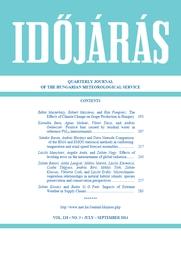IDŐJÁRÁS - angol nyelvű folyóirat
Vol. 118, No. 3 * Pages 193–291 * July - September 2014
 |
|
The effects of climate change on grape production in Hungary
Ildikó Mesterházy, Róbert Mészáros, and Rita Pongrácz
idojaras.2014.3.1 (p. 193–)
Ildikó Mesterházy, Róbert Mészáros, and Rita Pongrácz
idojaras.2014.3.1 (p. 193–)
Positive bias caused by residual water in reference PM10 measurements
Kornélia Imre, Ágnes Molnár, Viktor Dézsi , and András Gelencsér
idojaras.2014.3.2 (p. 207–)
Kornélia Imre, Ágnes Molnár, Viktor Dézsi , and András Gelencsér
idojaras.2014.3.2 (p. 207–)
Comparison of the BMA and EMOS statistical methods in calibrating temperature and wind speed forecast ensembles
Sándor Baran, András Horányi, and Dóra Nemoda
idojaras.2014.3.3 (p. 217–)
Sándor Baran, András Horányi, and Dóra Nemoda
idojaras.2014.3.3 (p. 217–)
Effects of leveling error on the measurement of global radiation
László Menyhárt, Angéla Anda, and Zoltán Nagy
idojaras.2014.3.4 (p. 243–)
László Menyhárt, Angéla Anda, and Zoltán Nagy
idojaras.2014.3.4 (p. 243–)
Microclimate-vegetation relationships in natural habitat islands: species preservation and conservation perspectives
Zoltán Bátori, Attila Lengyel, Miklós Maróti, László Körmöczi, Csaba Tölgyesi, András Bíró, Miklós Tóth, Zoltán Kincses, Viktória Cseh, and László Erdős
idojaras.2014.3.5 (p. 257–)
Zoltán Bátori, Attila Lengyel, Miklós Maróti, László Körmöczi, Csaba Tölgyesi, András Bíró, Miklós Tóth, Zoltán Kincses, Viktória Cseh, and László Erdős
idojaras.2014.3.5 (p. 257–)
Impacts of extreme weather in supply chains
Zoltán Kovács and Beáta Sz. G. Pató
idojaras.2014.3.6 (p. 283–)
Zoltán Kovács and Beáta Sz. G. Pató
idojaras.2014.3.6 (p. 283–)
IDŐJÁRÁS folyóirat

Az IDŐJÁRÁS a HungaroMet Nonprofit Zrt. negyedévenként megjelenő angol nyelvű folyóirata
Megrendelhető a journal.idojaras@met.hu címen.
A szerzőknek szánt útmutató itt olvasható.
Megrendelhető a journal.idojaras@met.hu címen.
A szerzőknek szánt útmutató itt olvasható.









